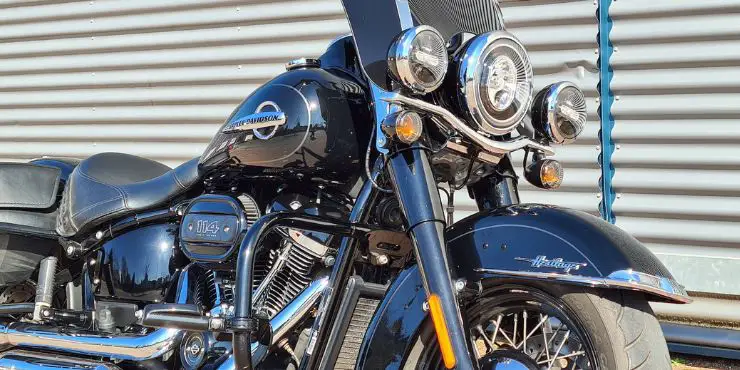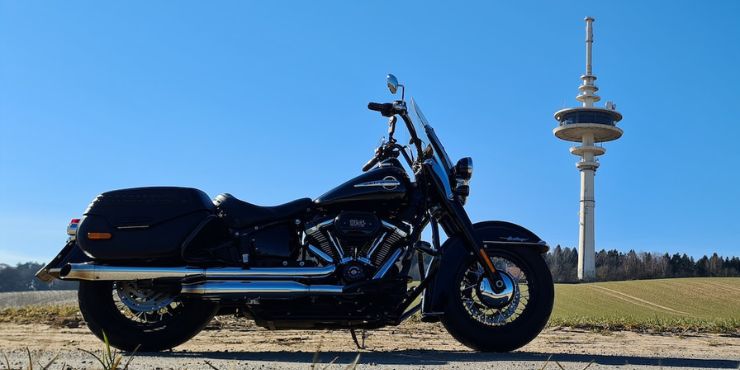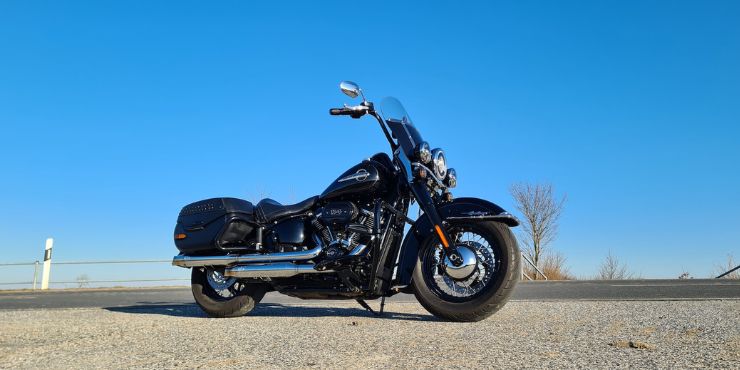Do you own a Harley-Davidson Softail or looking to buy one and want to know more about how does the suspension work in the bike? If so, then you’re certainly in the right place.
The Softail suspension features a hidden rear shock under the frame, giving it the appearance of a hardtail bike while providing modern comfort. The shock is mounted horizontally and absorbs impacts from the rear wheel.
In this article, you’ll get to know all about Harley-Davidson Softail suspension, Softail suspension how it works, how did the Harley-Davidson twin-shock and Softail systems come to be, and why you should adjust your bike’s suspension among others. Stick around to get all the answers that you are looking for.
Softail suspension how it works
Harley-Davidson Softail models feature adjustable rear shock absorbers that are located beneath the bike. Positioned horizontally beneath the bike, the shock is mounted to the frame just in front of the bike and to the swing arm in the rear. For the suspension system, the Softail utilizes a cage, and it looks like an old rigid frame. Instead of visible outboard shocks, the bike uses a pair of shocks that operate in extension. The shocks get longer once the suspension compresses for supporting and dampening the movement of the rear suspension.
How did the Harley-Davidson twin-shock and Softail system come to be
Before 1952, all Harley-Davidson bikes sported rigid frames without any rear suspensions. This pounded not just the rider, but the motorcycle’s components too. Spring-mounted seats were used for softening the dirt and pothole-laden roads at the time. However, most of them offered no damping, which means they became less effective at higher speeds and on bumpy roads.
One unique design that continued despite the introduction of rear suspension was the single post spring in the frame. It used to attach to the underside of the seat and worked similarly to a pogo stick. In 1952, Harley-Davidson came out with the 750K, a middleweight model that had a swinging-arm rear suspension.
In the fall of 1957, the Harley-Davidson Duo Glide was officially released. It featured a Hydra-Glide front end joined with a swinging-arm rear suspension controlled by a hydraulically dampened shock absorber on each side. It added 70 pounds to the bike, but after a couple of miles, riders accepted nothing less. Rigid frames fell out of favor quickly, much to the display of chiropractors, who started losing revenue at a rapid pace.
Mechanical engineer Bill Davis started experimenting with different suspension designs in the early 70s that looked like a rigid frame. It employed a swinging arm with a couple of shocks mounted under the seat. Later enhancement to the design put the shocks under the transmission. He freed up more space for a cleaner look and a horseshoe oil tank. Harley-Davidson then decided to buy this design from Bill Davis.
Harley-Davidson officially introduced the FXST Softail in 1984, before followed by the FLST Heritage in 1986. Bill Davis’ beloved FLSTF Fat Boy then came out in 1990. Until recently, the Softail was Harley-Davidson’s most popular line.
While the Softail and outboard shock suspensions work very differently, both have moderate road imperfections and compromise for the sake of styling. The traditional twin-shock rear suspension as seen on Sportster, Dyna, V-Rod, and Touring bikes makes use of a swingarm from the frame to the axle. The bikes come supported by a shock on each side of the wheel. Even a casual glance at the back of a twin-shock can reveal how the system works.
For the suspension system, the Softail utilizes a cage that looks like an old rigid frame for replacing the swingarm. However, it still pivots in the front while supporting a wheel in the rear. Instead of visible outboard socks, the Softail uses a pair of shocks that operate in extension. The shocks tend to get longer as the suspension compresses, for supporting and dampening the movement of the rear suspension.
Additionally, springs on the Softail shock absorbers are hidden under the chrome cover. This makes the shock appear drastically different, although it functions the same. This is reverse in direction as compared to a twin-shock system. Sportbikes and off-road bikes these days use single-shock rear suspensions effectively with gains in simplicity, adjustability, and reduction of mass. However, the style of twin rear shocks still remains due to the ease of production of inexpensive bikes.
Adjust your Harley-Davidson motorcycle’s suspension
The suspension is a key part of your Harley-Davidson bike. Between providing stability and comfort as you ride beside contributing to safety when it comes to braking and handling, both the rear and front aspects of this system pull a lot of work. However, to know if your bike’s suspension is working in a way that is best for you, you’ll need to know the basics.
No two riders are the exact same when it comes to their biking needs and driving styles. Since this is the case, why should the bike’s suspension be the same way? With advancements in technology that have made this entire process more accessible, there’s no reason not to adjust your bike’s suspension to fit your body.

Why should you be adjusting your bike’s suspension?
The Harley-Davidson Softail suspension is responsible for multiple aspects of your bike. The most significant one involves minimizing the impact of bumps while you’re riding. When the suspension is on the right settings, you will not feel a lot of those hits. When it is not, you will likely find yourself having an uncomfortable ride that does not handle as well as you would want it to do.
Adjusting the weight and height is essential as well. Although every motorcycle manufacturer comes with its default settings, they also know that not every rider will fit, sit, and ride the bike the same way. Adjusting the bike’s suspension to better suit the rider themselves could impact how well the bike handles as well. This allows you to easily customize it to your riding style. Moreover, used bikes might have the suspension tweaked to their previous owner instead of your personal needs.
Keeping that in mind, there isn’t one set of settings to adjust your Harley-Davidson bike’s suspension to run. With that said, what you will need out of your suspension depends on how you settle onto your motorcycle and the way you want to ride your bike. With that in mind, while there isn’t an ultimate set of suspension settings, there are certain practices to adjust your bike’s suspension.
Best practices to adjust your Harley-Davidson Softail suspension
When measuring your Harley-Davidson Softail’s suspension, you won’t be able to take care of all the things on your own. Having a friend can definitely help you get the tricky angles up and underneath your motorcycle. Moreover, they will be able to handle taking notes and calculations while you’re sitting on your bike to measure payload and more. As accurate measurements are the key to getting the riding experience that you want, assistance will be valuable.
Never neglect your notes
You might feel that once you have got your suspension in the prime settings, you wouldn’t want to mess with the settings again. However, that is rarely ever the case. You might change the gear setup, decide to drive in a different environment, or wish to see what a couple of tweaks can do to the bike’s overall performance. Keeping notes is key so that you can see what you have already noted in the current system. Moreover, keep track of other changes that you have made in the past.

Wear all your gear when you’re testing payload and sag
Remember to always wear the full range of equipment when you’re taking the measurements. All the little things that you’re putting on while you’re riding could add up and have an impact on the bike’s performance. Gear up to save yourself the trouble of realizing too late that you did not set up your bike the way it needed to be.
Conclusion
Thank you for reading. Hopefully, now you know a lot more about Harley-Davidson Softail suspension, Softail suspension how it works, how did the Harley-Davidson twin-shock and Softail systems come to be, and why you should adjust your bike’s suspension among others. The suspension in a Harley-Davidson Softail works very differently from other bikes. As the adjustable rear shock absorbers are located underneath the bike and are inverted, these function oppositely to conventional shocks. Instead of visible outboard shocks, the Harley-Davidson Softail uses a pair of shocks that operate in extension. These shocks get longer as the suspension compresses for supporting and dampening the movement of the rear suspension.

